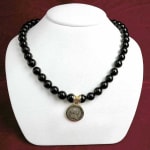Silver Denarius of Roman Emperor Trajan, 98 CE - 117 CE
Silver/Gold
FJ.1920
Further images
This stunning coin is set in a lovely 18-karat gold pendant, strung in a necklace of genuine black onyx beads, with an 18 karat gold clasp. C. Messius Quintus Trianus...
This stunning coin is set in a lovely 18-karat gold pendant, strung in a necklace of genuine black onyx beads, with an 18 karat gold clasp. C. Messius Quintus Trianus Decius was born about 201 A.D. in Lower Pannonia (now Hungary and Yugoslavia). He was governor of Lower Moesia (Southern Europe) from 234-238 A.D. Following the abortive rebellion of Upper Moesia, Philip dispatched Decius to restore order; but the rebels forced the latter, under threat of death, to “assume the purple” and march on Italy. In the ensuing battle Philip and his son were slain and Decius was left undisputed master of the Empire. Much of his short reign was spent in fighting the barbarians on the northern frontier, and in a battle against the Goths in 251 A.D. Decius was defeated and killed. Unfortunately, the reign of Decius is best known for his rigorous persecution of the Christians, in which Pope Fabian lost his life. Apart from Decius’ own coins, and those of his wife and sons, he also struck a series of coins commemorating most of the deified emperors from Augustus to Severus Alexander. A gem of contrasts, onyx is chalcedonic quartz frequently layered in different shades of contrasting color, most commonly the polar opposites black and white. Found in both the old and new worlds, onyx was used by the classical Greek and Romans to carve cameos and other personal jewelry. In fact, onyx was a favored stone of the famous Alexander the Great. Onyx was also used by the tribes of ancient Mexico to make masks and sacred ritual prominently in the breastplate of the high priest. Its lustrous, rich polished surface makes it a highly desirable stone for modern jewelry as well. The chief virtue of onyx as an amulet is that is seems to attract and absorb negative humors form the body of the wearer, causing relief from both physical pain and mental anxiety. Black onyx is especially thought to have unique properties, as back suggests both the presence of all colors and the absence of light. For that reason, it serves as a buffer from pain, a defensive wall against evil and illness.





